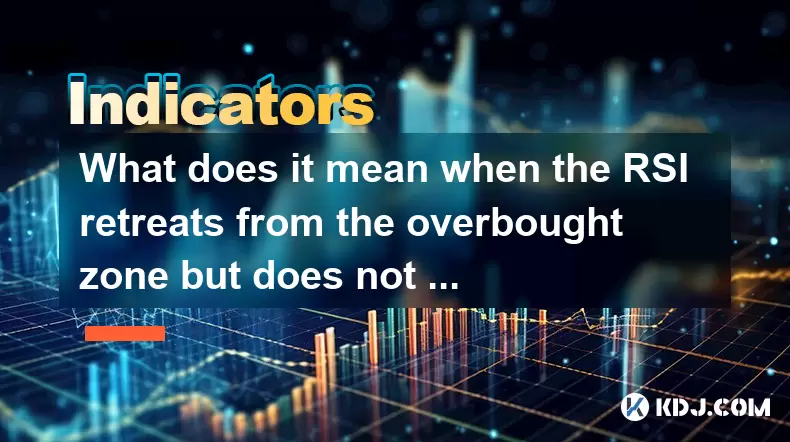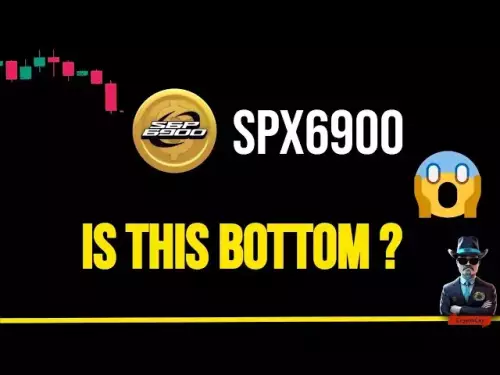-
 Bitcoin
Bitcoin $113100
-1.74% -
 Ethereum
Ethereum $4800
1.16% -
 XRP
XRP $3.041
0.36% -
 Tether USDt
Tether USDt $0.9999
0.02% -
 BNB
BNB $876.6
-0.40% -
 Solana
Solana $205.1
0.96% -
 USDC
USDC $0.0000
0.00% -
 Dogecoin
Dogecoin $0.2345
-0.10% -
 TRON
TRON $0.3629
0.40% -
 Cardano
Cardano $0.9260
1.91% -
 Chainlink
Chainlink $26.20
0.28% -
 Hyperliquid
Hyperliquid $46.04
2.89% -
 Sui
Sui $3.722
0.22% -
 Stellar
Stellar $0.4113
-0.53% -
 Ethena USDe
Ethena USDe $1.000
0.03% -
 Bitcoin Cash
Bitcoin Cash $590.3
0.39% -
 Avalanche
Avalanche $25.82
-0.01% -
 Hedera
Hedera $0.2504
-0.92% -
 Litecoin
Litecoin $119.1
-1.33% -
 UNUS SED LEO
UNUS SED LEO $9.598
0.03% -
 Toncoin
Toncoin $3.315
-1.69% -
 Shiba Inu
Shiba Inu $0.00001308
-1.02% -
 Uniswap
Uniswap $11.06
-2.10% -
 Polkadot
Polkadot $4.149
-1.10% -
 Dai
Dai $1.000
0.03% -
 Aave
Aave $350.7
-1.07% -
 Cronos
Cronos $0.1587
0.97% -
 Bitget Token
Bitget Token $4.664
-0.71% -
 Monero
Monero $274.5
3.42% -
 Ethena
Ethena $0.7021
-4.70%
What does it mean when the RSI retreats from the overbought zone but does not fall below the 50-day moving average?
When RSI retreats from overbought levels but stays above the 50-DMA, it signals weakening momentum within a bullish trend, often presenting a re-entry opportunity.
Aug 11, 2025 at 02:42 pm

Understanding the RSI and Overbought Conditions
The Relative Strength Index (RSI) is a momentum oscillator that measures the speed and change of price movements on a scale from 0 to 100. When the RSI rises above 70, it is generally considered to be in the overbought zone, indicating that the asset may be overvalued and due for a pullback. Traders use this signal to anticipate potential reversals or corrections. However, an overbought reading alone does not guarantee a price drop. The RSI can remain above 70 during strong uptrends, especially in bullish market conditions. Therefore, interpreting the RSI requires context, particularly when it begins to retreat from overbought levels.
When the RSI retreats from the overbought zone, it suggests that upward momentum is weakening. This could mean that buying pressure is decreasing, possibly leading to a consolidation or a downward correction. However, the implications of this retreat depend heavily on where the RSI settles and how price interacts with key moving averages.
Significance of the 50-Day Moving Average
The 50-day moving average (50-DMA) is a widely followed indicator used to identify the intermediate-term trend of an asset. It represents the average closing price over the past 50 trading days and acts as a dynamic support or resistance level. When the price is above the 50-DMA, the intermediate trend is typically considered bullish. Conversely, a price below the 50-DMA often signals bearish momentum.
In the context of RSI behavior, the relationship between the oscillator and the 50-DMA helps assess whether a pullback in momentum is temporary or indicative of a broader trend reversal. If the RSI retreats from overbought levels but stays above the 50-DMA, it suggests that while short-term momentum may be cooling, the underlying trend remains supported.
Interpreting RSI Retreat Without Breaching the 50-DMA
When the RSI drops from above 70 but does not fall below the 50-DMA, this configuration often reflects a healthy correction within an ongoing uptrend. It indicates that although the aggressive buying has slowed, the market structure remains intact. This scenario is commonly seen during bull market consolidations or pullbacks in strong trends.
Key implications include:
- The upward trend is still intact as long as price remains above the 50-DMA.
- The RSI cooling off from overbought reduces the risk of an extreme overextension.
- This could be a re-entry opportunity for traders who missed the initial move.
- The absence of a breakdown below the 50-DMA suggests sellers are not in control.
This behavior is particularly relevant in cryptocurrency markets, where volatility can push RSI into overbought territory quickly, yet strong trends can persist for extended periods.
How to Analyze Price and RSI Together
To properly assess this signal, traders should align RSI readings with price action and the 50-DMA. Here’s a step-by-step approach to evaluating the scenario:
- Plot the RSI indicator on your charting platform (e.g., TradingView, Binance, or MetaTrader).
- Set the RSI period to 14, which is the default and most commonly used setting.
- Add the 50-day simple moving average (SMA) to the price chart.
- Observe when the RSI crosses above 70, marking overbought conditions.
- Monitor the RSI as it begins to decline from above 70.
- Check whether the price remains above the 50-DMA during this RSI pullback.
- Look for candlestick patterns such as bullish engulfing or hammer formations near the 50-DMA, which may confirm support.
This multi-layered analysis helps confirm that the asset is not reversing but rather undergoing a momentum reset within a bullish framework.
Practical Trading Strategy Based on This Signal
Traders can use this RSI and moving average confluence to refine entry and exit points. A practical strategy involves the following steps:
- Wait for the RSI to enter the overbought zone (above 70) and then begin to decline.
- Confirm that the price has not closed below the 50-DMA on a daily or 4-hour chart, depending on your trading timeframe.
- Look for volume patterns — decreasing volume during the RSI pullback suggests lack of selling pressure.
- Enter a long position when the RSI stabilizes between 50 and 60 and shows signs of turning upward again.
- Place a stop-loss just below the 50-DMA to manage risk.
- Set a take-profit level near recent swing highs or based on a risk-reward ratio of at least 2:1.
This method is especially effective in high-cap cryptocurrencies like Bitcoin or Ethereum, where trends tend to be more sustained and moving averages act as reliable support.
Common Misinterpretations and Pitfalls
Many traders misinterpret an RSI retreat from overbought levels as a sell signal, especially without considering the broader trend. Selling simply because RSI drops from 75 to 65, while the price remains above the 50-DMA, can lead to premature exits from strong uptrends. Another pitfall is ignoring divergence signals — for example, if the price makes a new high but the RSI fails to surpass its prior peak, that bearish divergence could warn of weakening momentum, even if the 50-DMA holds.
Additionally, in low-liquidity altcoins, the RSI can give false signals due to pump-and-dump schemes. Always cross-verify with volume and on-chain data when possible.
Frequently Asked Questions
Can the RSI stay above 70 for a long time in a strong trend?
Yes, in strong bullish markets, especially in cryptocurrencies, the RSI can remain above 70 for extended periods. This does not necessarily indicate a reversal but reflects sustained buying pressure. The key is to avoid shorting based solely on overbought RSI without confirmation from price structure.
Does the 50-DMA need to be rising for this signal to be valid?
While not mandatory, a rising 50-DMA strengthens the bullish context. A flat or declining 50-DMA may suggest weakening momentum, making the RSI retreat more concerning. A rising slope confirms that the intermediate trend is still upward.
Should I use the 50-DMA on the RSI itself or on the price chart?
The 50-DMA should be applied to the price chart, not the RSI. The RSI is analyzed using horizontal thresholds (30, 50, 70), while moving averages on price help determine trend direction and support.
How do I adjust this strategy for different timeframes?
On shorter timeframes like 1-hour charts, use a 20-period moving average instead of 50-DMA for responsiveness. For weekly charts, consider the 50-week moving average. Adjust RSI sensitivity by testing 10-period RSI for faster signals, but always align with the dominant trend.
Disclaimer:info@kdj.com
The information provided is not trading advice. kdj.com does not assume any responsibility for any investments made based on the information provided in this article. Cryptocurrencies are highly volatile and it is highly recommended that you invest with caution after thorough research!
If you believe that the content used on this website infringes your copyright, please contact us immediately (info@kdj.com) and we will delete it promptly.
- Ozak AI, Binance, and Coinbase: Navigating the Crypto Landscape in 2025
- 2025-08-25 05:05:13
- Coinbase, Hacker, and Solana: Decoding the $8M Heist
- 2025-08-25 05:30:12
- Rare Find: The 1-Cent Coin Worth €6,000!
- 2025-08-25 02:45:28
- Hacktivism, Tokenization, and the Decentralized Future: A New Yorker's Take
- 2025-08-25 02:45:28
- PayPal, Stablecoin, and Boost: Riding the Wave of Digital Finance
- 2025-08-25 04:42:18
- UNI Price Gears Up for New Cycle: Analyst Outlook Bullish
- 2025-08-25 02:50:11
Related knowledge

What does it mean when the +DI and -DI cross frequently in the DMI indicator but the ADX is flattening?
Aug 11,2025 at 03:15am
Understanding the DMI Indicator ComponentsThe Directional Movement Index (DMI) is a technical analysis tool composed of three lines: the +DI (Positive...

What does the sudden appearance of a "dark cloud cover" candlestick pattern during an uptrend indicate?
Aug 13,2025 at 11:35am
Understanding the 'Dark Cloud Cover' Candlestick PatternThe dark cloud cover is a bearish reversal pattern in technical analysis that typically appear...

What does it mean when the moving average, MACD, and RSI all send buy signals simultaneously?
Aug 11,2025 at 01:42pm
Understanding the Convergence of Technical IndicatorsWhen the moving average, MACD, and RSI all generate buy signals at the same time, traders interpr...

What does it mean when both the KDJ indicator and the RSI show overbought signals simultaneously?
Aug 13,2025 at 11:35am
Understanding the KDJ Indicator in Cryptocurrency TradingThe KDJ indicator is a momentum oscillator derived from the Stochastic Oscillator, widely use...

What does it mean when the price is trading above the SAR indicator but the red dots are densely packed?
Aug 09,2025 at 11:49pm
Understanding the SAR Indicator and Its Visual SignalsThe SAR (Parabolic Stop and Reverse) indicator is a technical analysis tool used primarily to de...

What does it mean when the candlestick chart forms a "Morning Star" but trading volume is sluggish?
Aug 12,2025 at 06:28pm
Understanding the Morning Star Candlestick PatternThe Morning Star is a three-candle bullish reversal pattern commonly observed in cryptocurrency pric...

What does it mean when the +DI and -DI cross frequently in the DMI indicator but the ADX is flattening?
Aug 11,2025 at 03:15am
Understanding the DMI Indicator ComponentsThe Directional Movement Index (DMI) is a technical analysis tool composed of three lines: the +DI (Positive...

What does the sudden appearance of a "dark cloud cover" candlestick pattern during an uptrend indicate?
Aug 13,2025 at 11:35am
Understanding the 'Dark Cloud Cover' Candlestick PatternThe dark cloud cover is a bearish reversal pattern in technical analysis that typically appear...

What does it mean when the moving average, MACD, and RSI all send buy signals simultaneously?
Aug 11,2025 at 01:42pm
Understanding the Convergence of Technical IndicatorsWhen the moving average, MACD, and RSI all generate buy signals at the same time, traders interpr...

What does it mean when both the KDJ indicator and the RSI show overbought signals simultaneously?
Aug 13,2025 at 11:35am
Understanding the KDJ Indicator in Cryptocurrency TradingThe KDJ indicator is a momentum oscillator derived from the Stochastic Oscillator, widely use...

What does it mean when the price is trading above the SAR indicator but the red dots are densely packed?
Aug 09,2025 at 11:49pm
Understanding the SAR Indicator and Its Visual SignalsThe SAR (Parabolic Stop and Reverse) indicator is a technical analysis tool used primarily to de...

What does it mean when the candlestick chart forms a "Morning Star" but trading volume is sluggish?
Aug 12,2025 at 06:28pm
Understanding the Morning Star Candlestick PatternThe Morning Star is a three-candle bullish reversal pattern commonly observed in cryptocurrency pric...
See all articles

























































































